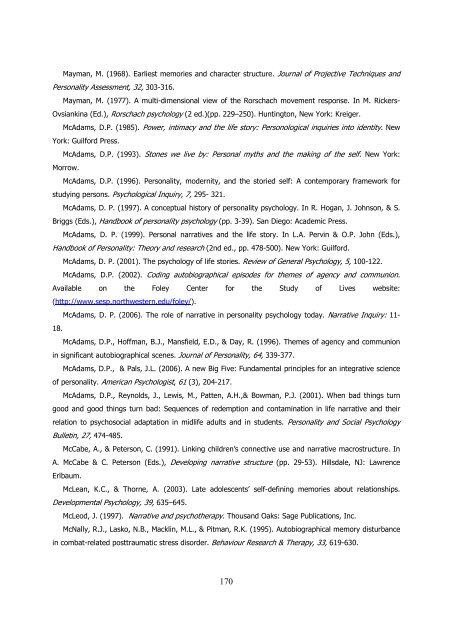LA NARRAZIONE AUTOBIOGRAFICA E IL FUNZIONAMENTO DEL SÉ
LA NARRAZIONE AUTOBIOGRAFICA E IL FUNZIONAMENTO DEL SÉ
LA NARRAZIONE AUTOBIOGRAFICA E IL FUNZIONAMENTO DEL SÉ
You also want an ePaper? Increase the reach of your titles
YUMPU automatically turns print PDFs into web optimized ePapers that Google loves.
Mayman, M. (1968). Earliest memories and character structure. Journal of Projective Techniques and<br />
Personality Assessment, 32, 303-316.<br />
Mayman, M. (1977). A multi-dimensional view of the Rorschach movement response. In M. Rickers-<br />
Ovsiankina (Ed.), Rorschach psychology (2 ed.)(pp. 229–250). Huntington, New York: Kreiger.<br />
McAdams, D.P. (1985). Power, intimacy and the life story: Personological inquiries into identity. New<br />
York: Guilford Press.<br />
McAdams, D.P. (1993). Stones we live by: Personal myths and the making of the self. New York:<br />
Morrow.<br />
McAdams, D.P. (1996). Personality, modernity, and the storied self: A contemporary framework for<br />
studying persons. Psychological Inquiry, 7, 295- 321.<br />
McAdams, D. P. (1997). A conceptual history of personality psychology. In R. Hogan, J. Johnson, & S.<br />
Briggs (Eds.), Handbook of personality psychology (pp. 3-39). San Diego: Academic Press.<br />
McAdams, D. P. (1999). Personal narratives and the life story. In L.A. Pervin & O.P. John (Eds.),<br />
Handbook of Personality: Theory and research (2nd ed., pp. 478-500). New York: Guilford.<br />
McAdams, D. P. (2001). The psychology of life stories. Review of General Psychology, 5, 100-122.<br />
McAdams, D.P. (2002). Coding autobiographical episodes for themes of agency and communion.<br />
Available on the Foley Center for the Study of Lives website:<br />
(http://www.sesp.northwestern.edu/foley/).<br />
18.<br />
McAdams, D. P. (2006). The role of narrative in personality psychology today. Narrative Inquiry: 11-<br />
McAdams, D.P., Hoffman, B.J., Mansfield, E.D., & Day, R. (1996). Themes of agency and communion<br />
in significant autobiographical scenes. Journal of Personality, 64, 339-377.<br />
McAdams, D.P., & Pals, J.L. (2006). A new Big Five: Fundamental principles for an integrative science<br />
of personality. American Psychologist, 61 (3), 204-217.<br />
McAdams, D.P., Reynolds, J., Lewis, M., Patten, A.H.,& Bowman, P.J. (2001). When bad things turn<br />
good and good things turn bad: Sequences of redemption and contamination in life narrative and their<br />
relation to psychosocial adaptation in midlife adults and in students. Personality and Social Psychology<br />
Bulletin, 27, 474-485.<br />
McCabe, A., & Peterson, C. (1991). Linking children’s connective use and narrative macrostructure. In<br />
A. McCabe & C. Peterson (Eds.), Developing narrative structure (pp. 29-53). Hillsdale, NJ: Lawrence<br />
Erlbaum.<br />
McLean, K.C., & Thorne, A. (2003). Late adolescents’ self-defining memories about relationships.<br />
Developmental Psychology, 39, 635–645.<br />
McLeod, J. (1997). Narrative and psychotherapy. Thousand Oaks: Sage Publications, Inc.<br />
McNally, R.J., Lasko, N.B., Macklin, M.L., & Pitman, R.K. (1995). Autobiographical memory disturbance<br />
in combat-related posttraumatic stress disorder. Behaviour Research & Therapy, 33, 619-630.<br />
170

















